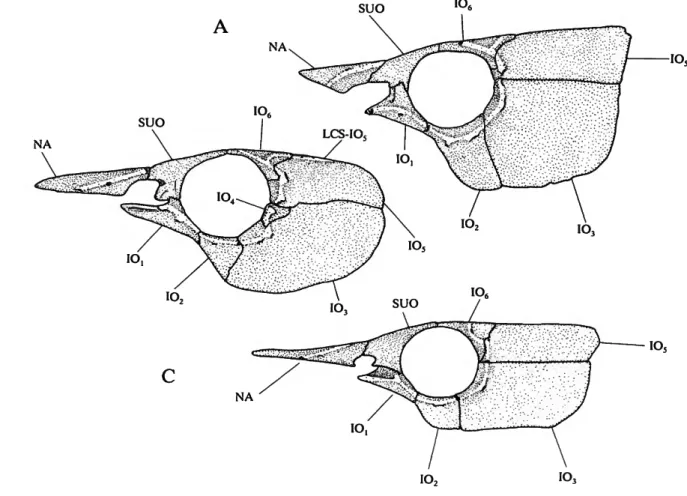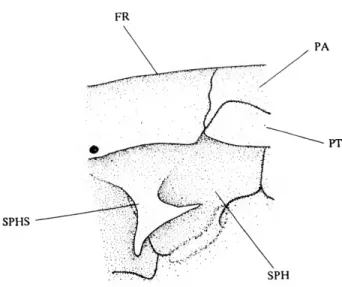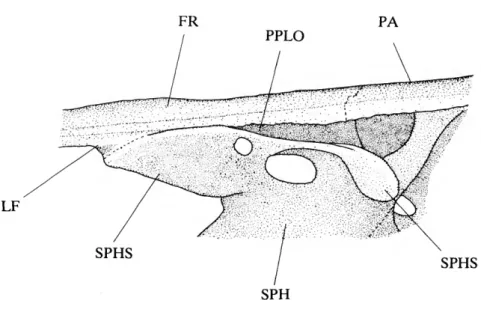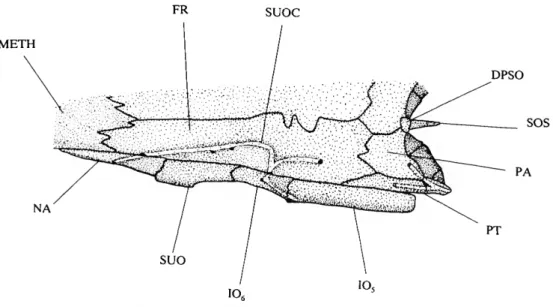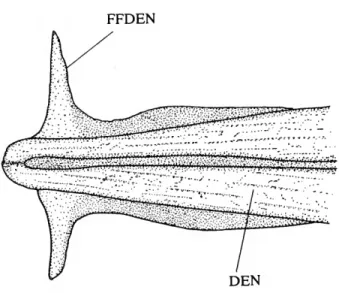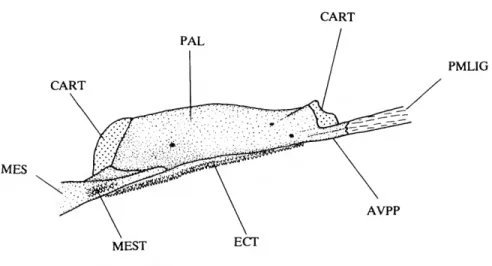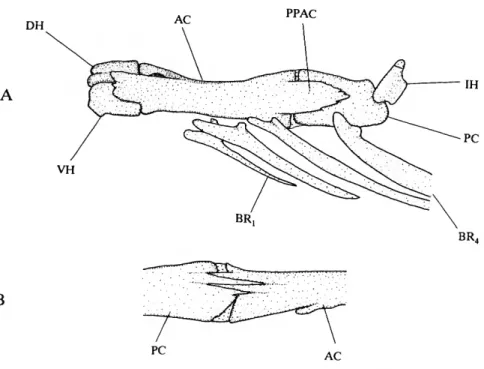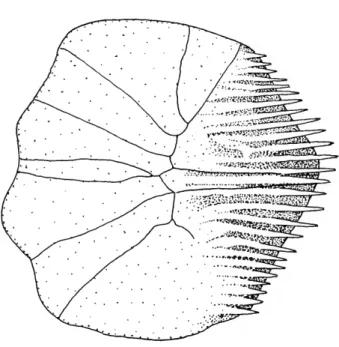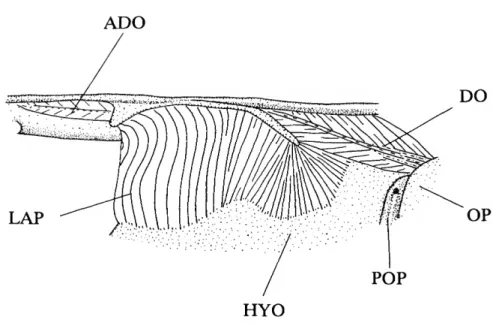*
The Neotropical Fish Family Ctenoluciidae
(Teleostei: Ostariophysi: Characiformes):
Supra and Intrafamilial Phylogenetic Relationships, with a Revisionary Study
RICHARD P. VARI
I
SMITHSONIAN CONTRIBUTIONS TO ZOOLOGY • NUMBER 564
Emphasis upon publication as a means of "diffusing knowledge" was expressed by the first Secretary of the Smithsonian. In his formal plan for the institution, Joseph Henry outlined a program that included the following statement: "It is proposed to publish a series of reports, giving an account of the new discoveries in science, and of the changes made from year to year in all branches of knowledge." This theme of basic research has been adhered to through the years by thousands of titles issued in series publications under the Smithsonian imprint, commencing with Smithsonian Contributions to Knowledge in 1848 and continuing with the following active series:
Smithsonian Contributions to Anthropology Smithsonian Contributions to Botany Smithsonian Contributions to the Earth Sciences Smithsonian Contributions to the Marine Sciences
Smithsonian Contributions to Paleobiology Smithsonian Contributions to Zoology
Smithsonian Folklife Studies Smithsonian Studies in Air and Space Smithsonian Studies in History and Technology
In these series, the Institution publishes small papers and full-scale monographs that report the research and collections of its various museums and bureaux or of professional colleagues in the world of science and scholarship. The publications are distributed by mailing lists to libraries, universities, and similar institutions throughout the world.
Papers or monographs submitted for series publication are received by the Smithsonian Institution Press, subject to its own review for format and style, only through departments of the various Smithsonian museums or bureaux, where the manuscripts are given substantive review.
Press requirements for manuscript and art preparation are outlined on the inside back cover.
I. Michael Heyman Secretary
Smithsonian Institution
S M I T H S O N I A N C O N T R I B U T I O N S T O Z O O L O G Y • N U M B E R 5 6 4
The Neotropical Fish Family Ctenoluciidae (Teleostei: Ostariophysi: Characiformes):
Supra and Intrafamilial Phylogenetic Relationships, with a Revisionary Study
Richard P. Vari
SMITHSONIAN INSTITUTION PRESS Washington, D.C.
1995
Vari, Richard P. The Neotropical Fish Family Ctenoluciidae (Teleostei: Ostariophysi:
Characiformes): Supra and Intrafamilial Phylogenetic Relationships, with a Revisionary Study.
Smithsonian Contributions to Zoology, number 564, 97 pages, 51 figures, 12 tables, 1995.—Osteological and soft anatomical features of the species of the Neotropical characiform family Ctenoluciidae and other characiforms were studied to examine the hypothesis that the family was monophyletic, and to advance an hypothesis of phylogenetic relationships within the family and of the Ctenoluciidae to proximate outgroups. A series of derived features corroborate the hypothesis of monophyly of the Ctenoluciidae and are congruent with the hypothesis that the Ctenoluciidae and Erythrinidae are sister groups. A less-extensive series of derived features indicate that the African family Hepsetidae is the sister group of the clade formed by the Ctenoluciidae and Erythrinidae, with the Neotropical family Lebiasinidae the sister group to the clade formed by those three families. Shared derived features of a variety of body systems define phylogenetic subunits of the Ctenoluciidae and characterize the majority of its species. The ctenoluciid genera Ctenolucius Gill (1861a) and Boulengerella Eigenmann (1903) are defined as monophyletic units.
Luciocharax Steindachner (1878) and Belonocharax Fowler (1907) are considered synonyms of Ctenolucius, with Spixostoma Whitley (1951) placed as a synonym of Boulengerella.
Two species are recognized in Ctenolucius. Ctenolucius hujeta (Valenciennes in Cuvier and Valenciennes, 1849) ranges from the Lago Maracaibo basin of northwestern Venezuela through the Rfo Magdalena system to the Rio Sinu of northwestern Colombia. Ctenolucius beani (Fowler, 1907) occurs in the Rio Atrato and Rio San Juan basins of northwestern Colombia and the rivers of the Pacific slopes of Panama as far west as Veraguas Province. Luciocharax insculptus Steindachner (1878) is a synonym of C. hujeta, and Luciocharax striatus Boulenger (1911) is a synonym of C. beani.
Five species are recognized in Boulengerella. Boulengerella lateristriga (Boulenger, 1895) occurs in the Rio Negro drainage of the Amazon basin in Brazil and Venezuela and uppermost portions of the Rio Orinoco in southern Venezuela. Boulengerella maculata (Valenciennes in Cuvier and Valenciennes, 1849) is widely distributed through the Rio Amazonas, Rio Tocantins, and Rio Orinoco basins. Boulengerella lucius (Cuvier, 1819) occurs in the Rio Amazonas and Rio Orinoco systems. Boulengerella cuvieri (Agassiz in Spix and Agassiz, 1829) is widespread through the Rio Orinoco, Rio Amazonas, and Rio Tocantins basins, the Essequibo River of Guyana, the Oyapock River along the boundary between French Guiana and Brazil, and the coastal rivers of Amapd and Par£ states in Brazil. Boulengerella xyrekes, new species, a relatively rare form, inhabits the Rio Orinoco and Rio Amazonas basins. Xiphostoma taedo Cope (1872) is a synonym of B. maculata. Xiphostoma oseryi Castelnau (1855) and Xiphostoma ocellatum Schomburgk (1841) are considered synonyms of B. cuvieri. Xiphostoma longipinne Steindachner (1876), based on a juvenile from the mouth of the Rio Negro in Brazil, tentatively is considered a synonym of B. cuvieri. Reports of Boulengerella from the Rio Pamafba of northeastern Brazil and in the Rio de La Plata system in Argentina either are based on specimens with questionable locality data or are probable misidentifications.
Keys are provided to distinguish Ctenolucius and Boulengerella and for the species in each genus. Lectotypes are designated for Xiphostoma hujeta Valenciennes, Luciocharax insculptus Steindachner, Xiphostoma ocellatum Valenciennes, and Luciocharax striatus Boulenger.
The phylogenetic biogeography of the group indicates a vicariance event between the Hepsetidae and the lineage consisting of the Ctenoluciidae and Erythrinidae associated with, or predating, the final separation of Africa and South America about 85 mya. Fossil and distributional data indicate that major cladogenesis within the Ctenoluciidae and Erythrinidae predates the late Miocene.
OFFICIAL PUBLICATION DATE is handstamped in a limited number of initial copies and is recorded in the Institution's annual report, Smithsonian Year. SERIES COVER DESIGN: The coral Montastrea cavernosa (Linnaeus).
Library of Congress Cataloging-in-Publication Data Vari, Richard P.
The neotropical fish family Ctenoluciidae (Teleostei: Ostariophysi: Characiformes) ; supra and intrafamilial phylogenetic relationships, with a revisionary study / Richard P. Vari.
p. cm.—(Smithsonian contributions to zoology ; no. 564) Includes bibliographical references (p. ) and index.
1. Ctenoluciidae—South America—Phylogeny. 2. Ctenoluciidae—South America—Classifica- tion. I. Title. II. Series.
597'.52—dc20 94-36338
© The paper used in this publication meets the minimum requirements of the American National Standard for Permanence of Paper for Printed Library Materials Z39.48 1984.
Contents
Page
Introduction 1 Acknowledgments 2 Methods and Materials 2 Terminology 5 Abbreviations 5 Institutional Abbreviations 5 Text and Figure Abbreviations 5 Character Description and Analysis 6 Antorbital 9 First Infraorbital and Supraorbital 10 Fourth Infraorbital 11 Fifth Infraorbital 11 Sixth Infraorbital 12 Nasal 12 Vomer 13 Lateral Ethmoid 13 Frontal 13 Dilatator Groove 13 Epiphyseal Bar 15 Laterosensory Canals in Frontal and Parietal 16 Pterotic 17 Supraoccipital 17 Suprapreopercle 18 Jaws and Associated Soft Tissues 18 Upper Jaw 18 Lower Jaw 20 Dentition 21 Palatine 22 Ectopterygoid Teeth 23 Mesopterygoid Teeth 24 Metapterygoid-Quadrate Fenestra 24 Basihyal 24 Anterior and Posterior Ceratohyals 24 Branchiostegal Rays 25 Interhyal 26 Gill-Rakers 26 Postcleithra 26 Weberian Apparatus 27 Tripus 27 Fourth Pleural Rib 27 Ligament between Tripus and Fourth Pleural Rib 27 Transverse Process of Third Neural Arch 27 Laterosensory Canal System on Body 28 Scales 28 Squamation at Posterodorsal Margin of Head 29 Anal Fin 30
in
Sexual Dimorphism 30 Ontogenetic Variation 31 Dorsal-Fin Position 31 Adipose Fin 32 Caudal Fin Bony Stays 32 Myology 32 Dilatator Operculi Muscle 32 Adductor Mandibulae Muscle 34 Levator Arcus Palatini Muscle 34 Pigmentation 34 Body and Head Pigmentation 34 Fin Pigmentation 34 Phylogenetic Reconstruction 35
Monophyly of the Lebiasinidae, Hepsetidae, Erythrinidae, and Ctenoluciidae Clade 35 Comments on Monophyly of Lebiasinidae and Subunits 35 Monophyly of the Hepsetidae, Erythrinidae, and Ctenoluciidae Clade 37 Comments on Monophyly of Hepsetidae 37 Monophyly of the Erythrinidae and Ctenoluciidae Clade 37 Comments on Monophyly of Erythrinidae 38 Monophyly of Ctenoluciidae 38 Monophyly of Ctenolucius 39 Monophyly of Boulengerella 40 Intrageneric Relationships in Boulengerella 40 Family CTENOLUCIIDAE Schultz, 1944 41 Key to Ctenolucius Gill and Boulengerella Eigenmann 42 Genus Ctenolucius Gill, 1861 42 Key to Species of Ctenolucius Gill, 1861 43 Ctenolucius hujeta (Valenciennes in Cuvier and Valenciennes, 1849) 43 Ctenolucius beani (Fowler, 1907) 52 Genus Boulengerella Eigenmann, 1903 57 Key to Species of Boulengerella Eigenmann, 1903 58 Boulengerella lateristriga (Boulenger, 1895) 59 Boulengerella maculata (Valenciennes in Cuvier and Valenciennes, 1849) . . . 63 Boulengerella lucius (Cuvier, 1816) 69 Boulengerella cuvieri (Agassiz in Spix and Agassiz, 1829) 74 Boulengerella xyrekes, new species 82 Phylogenetic Biogeography of the Ctenoluciidae and Proximate Outgroups 86 Resumo 89 Literature Cited 90 Index 96
The Neotropical Fish Family Ctenoluciidae (Teleostei: Ostariophysi: Characiformes):
Supra and Intrafamilial Phylogenetic Relationships, with a Revisionary Study
Richard P. Vari
Introduction
Fishes of the family Ctenoluciidae, with their elongate tapering heads and bodies, large gapes, numerous relatively small jaw teeth, and posteriorly positioned dorsal fins, are among the most distinctive of Neotropical characiforms.
Ctenoluciids also are among the larger New World characi- forms, with Boulengerella cuvieri reaching at least 675 mm SL in the Amazon basin. In addition to their importance in the aquatic ecosystem as high-level predators (Smith, 1981:22), various ctenoluciids are exploited for food by both artesanal fishermen and commercial fisheries (Mendes dos Santos et al., 1984) and for export in the aquarium fish trade (Castro, 1986:3).
Ctenoluciids have a broad geographic distribution in the streams, rivers, and lentic water bodies of the lowlands and lower elevation highlands on both sides of the Andean Cordilleras. Ctenolucius Gill ranges from the Pacific versant rivers of western Panama, through the rivers of northwestern and northern Colombia, to the Lago Maracaibo basin of northwestern Venezuela. Complementing this distribution is the occurrence of Boulengerella Eigenmann in the massive Orinoco, Amazon, and Tocantins basins and the shorter coastal rivers of Guyana, French Guiana, and the states of Amapa and Par£ in Brazil.
The first ctenoluciid species (lucius) was described by
Richard P. Vari, Department of Vertebrate Zoology, National Museum of Natural History, Smithsonian Institution, Washington, D.C. 20560.
Review Chairman: Stanley H. Weitzman, National Museum of Natural History, Smithsonian Institution.
Reviewers: CarlJ. Ferraris, Jr., California Academy of Sciences, San Francisco; and Carlos A.S. de Lucena, Pontificia Universidade Catdlica do Rio Grande do Sul, Porto Alegre, Brazil.
Cuvier (1816) in Hydrocynus Cuvier. Hydrocynus, as defined by that author, consisted of six species from South America and Africa, now assigned to a variety of different characiform families (sensu Greenwood et al., 1966). The first author to propose a distinct taxon to encompass what now are considered ctenoluciids was Agassiz in Spix and Agassiz (1829), who placed lucius in the newly proposed Xiphostoma and who described a second species, cuvieri, in the genus. Xiphostoma, however, already was occupied in Hemiptera.
During the next 83 years, five nominal genera and 10 nominal species of ctenoluciids were proposed by authors commencing with Valenciennes in Cuvier and Valenciennes (1849), and ending with Boulenger (1911). Subsequent taxonomic treatments have differed on which of the nominal genera and species should be recognized and as to the exact distributional ranges of the recognized species.
These problems were largely a consequence of the limita- tions inherent to many of the studies dealing with ctenoluciids.
Most discussions focused on the representatives of the family in a particular river basin or political unit (e.g., Dahl, 1971).
Only Schultz' (1950) relatively brief treatment of the family attempted to deal with the spectrum of generic and specific problems among ctenoluciids. However, with the exception of the Ctenolucius populations from Lago Maracaibo, Schultz examined only a handful of specimens from scattered localities across the family range. Those limited samples were insuffi- cient to permit a critical evaluation of the validity of various nominally recognizable species or the estimation of the actual distribution of the various ctenoluciid taxa.
The relationships of the Ctenoluciidae to other characiforms has not been critically examined based on shared derived features. Regan (1911) compared what we now consider ctenoluciids to taxa presently assigned to the Characidae.
Whether that comparison was intended as a hypothesis of close
relationship of the Ctenoluciidae (his Xiphostomidae) with the Characidae is unclear. Gregory and Conrad (1938:321) proposed the subfamily Sarcodacinae for taxa assigned by Greenwood et al. (1966) and many subsequent authors to the New World families Ctenoluciidae (Luciocharax) and Chara- cidae (Acestrorhynchus) and the African family Hepsetidae (Sarcodaces). Roberts (1969) expanded on that hypothesis by highlighting various features shared by the Ctenoluciidae and the African characiform family Hepsetidae. Fink and Fink (1981), in turn, proposed that the Ctenoluciidae, Erythrinidae, and Hepsetidae form a monophyletic group on the basis of dentition characters. That intriguing hypothesis of trans- Atlantic relationships has not, however, been critically exam- ined within the framework of a more encompassing rigorous phylogenetic study.
This paper has five primary aims: (1) to further examine the hypothesis of the monophyly of the Ctenoluciidae and its relationships within the Characiformes; (2) to define Boulengerella and Ctenolucius as monophyletic units; (3) to resolve the intrafamilial phylogenetic relationships; (4) to determine the recognizable species of Ctenolucius and Boulengerella and estimate their geographic distributions; (5) to determine what the information about the phylogeny and distribution of ctenoluciids might tell us about the biogeogra- phic history of the family.
ACKNOWLEDGMENTS
I am greatly indebted to the following individuals and institutions for the loan and exchange of specimens, informa- tion, hospitality during visits, and other types of assistance:
Gareth J. Nelson, M. Norma Feinberg, Carl J. Ferraris, Jr., and Barbara Brown (AMNH); Scott A. Schaefer and William G.
Saul (ANSP); Gordon J. Howes and Darrell J. Siebert (BMNH); Tomio Iwamoto and David Catania (CAS); Barry Chernoff and Mary Anne Rogers (FMNH); Lawrence M. Page, Kevin S. Cummings, and Michael R. Retzer (INHS); Camm C.
Swift and Jeffrey A. Seigel (LACM); Antonio Machado- Allison and Francisco Provenzano (MBUCV); Karsten E.
Hartel (MCZ); Carlos A. Lasso (MHNLS); Christophe Dufour (MHNN); Guy Duhamel (MNHN); Randy D. Mooi (MPM), Herndn Ortega (MUSM); Na6rcio A. Menezes, Heraldo A.
Britski, Jos6 L. Figueiredo and Osvaldo T. Oyakawa (MZUSP); Barbara Herzig (NMW); Sven O. Kullander and Erik Ahlander (NRM); Erling Holm and Richard Winterbottom (ROM); George Burgess and John Matter (UF); Douglas W.
Nelson and William L. Fink (UMMZ); Han Nijssen and Isaac Isbriicker (ZMA), Heiko Bleher of Aquaprint, Frankfurt, Germany, and Thomas D. Munroe (National Marine Fisheries Service).
Hemdn Ortega (MUSM) and Antonio Machado-Allison (MBUCV) provided indispensable assistance and guidance during collecting expeditions. Michael Goulding, formerly of the Museu Goeldi, Bel£m, Brazil, and now of the Rainforest
Alliance, kindled my interest in the family with the extensive series of specimens he had collected in the Amazon basin. The maps of South America are based on a map prepared by Marilyn Weitzman (NMNH). Sven O. Kullander and Anita Hogeborn-Kullander (NRM) and Heiko Bleher (Aquaprint, Frankfurt, Germany) generously provided color transparencies that are the basis for many "Life Coloration" descriptions. The photographs were prepared by T. Britt Griswold (NMNH).
Leslie Overstreet (Smithsonian Institution Libraries) provided valuable assistance in locating rare volumes. Technical support during this project was provided by Thomas M. Orrell, Lisa F.
Palmer, William F. Hoffman, and, in particular, Sandra J.
Raredon. Research, collecting efforts, and museum studies in Brazil, Peru, and Venezuela associated with this paper were funded by the Neotropical Lowland Research Program of the International Environmental Sciences Program of the Smith- sonian Institution. This paper benefited from numerous very useful comments and suggestions from James C. Tyler, Carlos A.S. de Lucena, and Carl. J. Ferraris, Jr., and the careful copy editing and final composition of the paper by Diane M. Tyler, Smithsonian Institution Press.
METHODS AND MATERIALS
Measurements were made with dial calipers and data recorded to tenths of a millimeter for distances under 100 mm and to a millimeter for larger distances. Counts and measure- ments were made on the left side of specimens when possible.
Standard length (SL) measurements were made from the bony tip of the snout, not including the fleshy appendage at the end of the snout present in many ctenoluciids (particularly species of Boulengerella). Measurements of snout length, orbital diameter, and postorbital length were made from the bony margin of the orbit. Interorbital width was taken at the joint between the supraorbital and sixth infraorbital on each side of the head. Length of the lower jaw was measured from the posteroventral comer of the retroarticular to the tip of the dentary, not including the fleshy anterior projection on that portion of the jaw in various ctenoluciids. In tables and the text, subunits of the head are presented as proportions of head length (HL). Head length and measurements of body parts are given as proportions of standard length (SL).
Counts of lateral-line scales include all scales, pored and unpored, in that midlateral series. Counts of middorsal scales include all rows between the posterior margin of the supraoc- cipital and the dorsal fin and between the dorsal fin and adipose fin. Middorsal scales anterior to the dorsal fin are somewhat irregularly arranged, introducing some uncertainty into that count. Counts of scales in a transverse series are made from the lateral-line series to the origin of the dorsal or anal fins in Ctenolucius and the species of Boulengerella with complete lateral lines (lucius, cuvieri, xyrekes) and from the origin of the dorsal fin to the midventral line in the species of Boulengerella with truncate lateral lines {lateristriga, maculata). Vertebral
counts were taken from radiographs, with the fused PUj + U, considered a single bone and the vertebrae incorporated into the Weberian apparatus counted as four elements. Numbers in parentheses following a particular vertebral count are the numbers of radiographed specimens with that count. In counts of fin rays, the unbranched fin rays are indicated by lower case roman numerals, and the branched fin rays as arabic numerals.
Counts of the outer series of maxillary and dentary include teeth in the process of replacement, as indicated by a gap in an otherwise continuous series of teeth. The inner tooth row on the upper jaw referred to by Schultz (1950:50) as "vomerine teeth"
can be seen to be premaxillary teeth when examined in cleared and stained specimens.
The first entry under the "Material Examined" section for each species summarizes the number of specimens examined (with the number in parentheses being the specimens forming the basis for meristic and morphometric data for both head and body parts, and the range of standard lengths for those specimens). A number of the specimens were damaged to varying degrees making it impossible to take all data in every instance. Because of the elongate bodies of ctenoluciids, many specimens were twisted during preservation making the measurement of their standard length impossible. Proportional data on subunits of the head, along with meristic data, were taken from those specimens whenever possible, and the number of specimens from which such partial data were taken is noted in the summary entry.
The summary entry is followed by the listing of material, including collection locality, institutional abbreviation, catalog number, and number of specimens in the lot (in parentheses, the number of specimens in the lot from which counts and measurements were taken if that is less than the total number of specimens, and the range of standard lengths (in mm) of the individuals for which standard length could be determined).
Collector and date of collection are provided only for new species.
Geographic descriptors are in the sequence of country (capitalized), state, province, department or district (italicized), followed by specific locality data. The common names are those reported in the literature. In the synonymies for each species, localities are presented as originally cited, followed by modern or corrected equivalents, in parentheses, if that differs.
Genders of generic names follow Eschmeyer and Bailey in Eschmeyer (1990). Authorship of genera and species in Spix and Agassiz (1829) follows Kottelat (1988).
Osteological preparations were cleared and counterstained for cartilage and bone using a modification of the method outlined by Taylor and Van Dyke (1985). Previously cleared specimens stained solely with alizarin Red-S, dry skeletons, and dissected alcohol-preserved specimens were used as supplemental sources of osteological data.
The following specimens are the basis of text illustrations or specific observations noted in the text. Number of specimens and the standard length of specimens in each lot follow
museum catalog numbers. Head length is listed for some skeletal preparations. Specimens are cleared and counterstained and stored in glycerin unless indicated as being dry skeletons (S), whole specimens examined via radiographs (R) or external examination (E), or specimens dissected to examine osteologi- cal (D) or myological (M) features.
Characidae
Acestrorhynchus falcatus. Surinam, Nickerie District, Coran- tijn River basin, tributary to Sisa Creek; USNM 225614, 2, 81.0-85.1 mm. Venezuela, Amazonas, Rio Mavaca;
AMNH 93098, head only, 70.0 mm HL (S).
Acestrorhynchus guianensis. Venezuela, Guarico, Guariquito River, USNM 258162, 1, 116 mm (M).
Acestrorhynchus heterolepis. Venezuela, Amazonas, Rio Ma- vaca; AMNH 93095, head only, 98.0 mm HL (S).
Acestrorhynchus macrolepis. Surinam, Nickerie District, Co- rantijn River basin; USNM 278988, 1, 128 mm.
Agoniates species. Brazil, Amazonas, mouth of Rio Ic,a; USNM 243222, 1, 106 mm.
Alestes dentex. Mali, Mopti, Niger River, USNM 224869, 1, 138 mm (R).
Alestes lateralis. Botswana, Xuguna; USNM 285664, 1, 75.0 mm.
Brycinus longipinnis. Togo, Togble-Kope; USNM 285665, 3, 45.8-54.0 mm. Ghana, Half Assini, Millers Wharf, USNM 310061,4, 74.8-85.6 mm (R).
Brycinus macrolepidotus. Togo, Togble-Kope; USNM 310067, 1, 120 mm.
Brycinus nurse. Atbara River, USNM 52088 and 52089, 2, 112-133 mm (R); USNM 310088, 4, 43.6-89.7 mm.
Brycon argenteus. Panama, Comaraca Kuna Yala, Quebrada Sigdi at Pingandi; USNM 293136, 1, 100 mm.
Brycon falcatus. Surinam, Corantijn River, USNM 226161, 2, 71.3-78.3 mm.
Bryconaethiops species. Zaire, Stanleyville; USNM 176365,2, 81.4-84.6 mm (R).
Crenuchus spilurus. Surinam, Nickerie District, Lana Creek;
USNM 225630, 4, 21.7-28.2 mm. Venezuela, Amazo- nas, Cano Loro, where crossed by road from San Carlos de Rio Negro to Solano; USNM 270132, 4, 37.5-39.0 mm.
Hydrocynus species. Volta [Ghana], Black Volta River, USNM 231342, 3, 38.5-59.2 mm.
Hydrolycus pectoralis. Peru, Rio Ucayali; USNM 231549, 1, 167 mm.
Lepidarchus adonis. Ghana, Aluku; USNM 267290, 5, 14.6-18.1 mm.
Micralestes acutidens. Cameroon, Cross River system; USNM 304033, 4, 50.9-59.3 mm (R).
Moojenichthys myersi. Brazil, Bahia, Rio do Brac,o, 2 km SW of town of Rio do Brac,o (~14°38'S, 39° 1 6 ^ ) ; USNM 304497, 1, 84.8 mm.
Oligosarcus hepsetus. Brazil, Santa Catarina, municipio de Tubarao, Rio Correia; USNM 278988, 1, 110 mm.
Petersius intermedius. Ghana, Dayi River, Gbefi; USNM 310844, 9, 34.8-49.7 mm (R); Ghana, Dayi River, USNM 326309, 2, 32.5-36.5 mm.
Phenacogrammus interruptus. 7jai\xQ\ USNM 163405, 2, 55.7- 57.8 mm (R).
Phenacogrammus pabrensis. Ghana, Dayi River, USNM 326209, 2, 32.3-35.4 mm.
Rhaphiodon vulpinus. Brazil, Amazonas, Rio Solimoes, 15 km W of Coari; USNM 231549, 4,42.1-48.0 mm.
Salminus species. Peru, Madre de Dios, Parque Nacional Manu, Pakitza, Rfo Manu; USNM 319315, 1, 110 mm.
Triportheus angulatus. Venezuela, Bolivar, small cano con- necting with Rio Orinoco, immediately S of El Burro;
USNM 270343, 2, 67.0-74.1 mm.
Citharinidae
Citharinus citharus. Egypt, Nile River; USNM 52146,1,218.7 mm (only gill-arches cleared and stained).
Ctenoluciidae
Boulengerella cuvieri. Brazil, Para\ Rio Capim and tributary streams; USNM 319784, 1, 147 mm (head myology examined before clearing and staining). Venezuela, Amazonas, Rio Mavaca; AMNH 93100, head only, 101.5 mm HL (S). Venezuela, Barinas, Rio Apure basin, USNM 326304, 1, 25.5 mm SL.
Boulengerella lateristriga. Venezuela, Amazonas, small cano off Cano Urami, just upriver of Santa Lucia; USNM 270331, 1, 145 mm and 1, 139 (M).
Boulengerella lucius. Brazil, Para", Rio Trombetas, Oriximina;
USNM 319782, 1, 145 mm. Aquarium specimen without locality data; USNM 326202, 1, 99.0 mm.
Boulengerella maculata. Venezuela, Guarico, quebrada drain- ing into Rio Orinoco, near Paramana; USNM 391780, 1, 156 mm. Brazil, Rondonia, Rio Machado; USNM 319781, 1, 127 mm. Brazil, Amazonas, Rio Urubu, 25 km from Itacoatiara; USNM 179506, 1, 150 mm (M).
Venezuela, Amazonas, Rio Mavaca; AMNH 93099, head only, 94.5 mm HL (S).
Boulengerella xyrekes. Brazil, Amazonas, Rio Negro basin, Rio Maraud; USNM 319783,1,167 mm (head myology examined before clearing and staining).
Ctenolucius beani. Panama, Darien, Rio Tuira, x/i km above Boca de Cupe; USNM 293169, 1,143 mm. Panama, Rfo Pirre; USNM 310488, 1, incomplete (M). Panama, coastal stream south of Chepo, USNM 226435, 1, 161 mm (M).
Ctenolucius hujeta. Venezuela, Zulia, Rfo Motatan system, Rfo San Pedro, at bridge; USNM 121334, 1, 140 mm and 1,
138 (M).
Cyprinidae
Opsariichthys bidens. China, Anhwe, Ningkwo; AMNH 10955, 1, 80.2 mm.
Distichodontidae
Congocharax olbrechtsi. Zaire, Zaire River, stream flowing into Lac TUmba, near Bikoro; USNM 227394, 2, 21.7-23.5 mm.
Distichodus species. Zaire, Zaire River basin, Stanley Pool;
USNM 175436, 66.7 mm.
Eugnatichthys species. No locality data; USNM 326204, 1, 96.0 mm.
Hemistichodus species. No locality data; USNM 326203, 1, 35.5 mm.
Mesoborus species. No locality data; USNM 285674, 1, 74.5 mm.
Nannocharax intermedius. West Africa; USNM 231555, 2, 50.7-63.4 mm.
Paradistichodus dimidiatus. Ghana, Dayi River; USNM 213556, 2, 45.6-47.3 mm.
Xenocharax spilurus. Gabon, Lac Ezanga; USNM 227693, 1, 89.3 mm.
Erythrinidae
Erythrinus erythrinus. Trinidad and Tobago, Trinidad, N flowing stream at mile 71 [= km 113.6] of Southern Main Road, close to Banasse; USNM 260223, 1, 102 mm.
Brazil, near Para [=Para\ Belem]; USNM 163759, 1, incomplete (D). Brazil, Mato Grosso, upper Rio Juruena;
USNM 199203, 1, 109 mm (M).
Hoplerythrinus unitaeniatus. Bolivia, Beni, small pond S of El Porvenir Biological Station, 41 airkm E of San Borja;
USNM 305370, 1, 108 mm. Surinam, Nickerie, small stream entering east side of Corantijn River about 300 m N of Amotopo boat landing; USNM 225313, 1, 36.2 mm.
Peru, Madre de Dios, small stream draining into Rfo Tambopata, Reserva National de Tambopata; USNM 264020, 2, 79.3-84.0 mm and 1, 97.2 mm (M).
Hoplias cf. malabaricus. Bolivia, Beni, canal by El Porvenir Biological Station, 41 airkm E of San Borja; USNM 303853, 1, 95.5 mm. Brazil, Amazonas, Lago Terra Preta, Januari; USNM 308914, 1, 19.0 mm. Brazil, Amazonas, Ilha de Marchantaria; USNM 308910, 1,94.0 mm (M). Brazil, Ceara, Reservoir at Pentecoste; USNM 310671, 1, 119 mm (M). Venezuela, Monagas, Rfo Orinoco, Barrancas; USNM 226265, 2, 22.8-26.5 mm.
Hepsetidae
Hepsetus odoe. Liberia, St. Johns River, 0.5 mi [0.8 km]
downstream of bridge at Sanniquellie District border;
USNM 179331, 1, 107 mm. Cameroon, Cross River
system, Akwen Gorge, stream draining into Munaya River; USNM 304047, 1, 121 mm. Cameroon, Manyu, Cross River system; USNM 303782, 3, 18.7-41.0 mm.
Cameroon, upper Cross River system, tributaries of Marube River, USNM 304096, 1, 119 mm (M).
Lebiasinidae
Copella eigenmanni. Brazil, Marapanim; MZUSP uncat, 2, 29.0-36.2 mm.
Copella species. Surinam, von Blummenstein Reservoir (Bro- kopondo); ZMA 106.131, 1, 39.0 mm.
Lebiasina bimaculata. Ecuador, Esmeraldas Province; USNM 326205, 1, 102 mm; USNM 326206, 1, 97.3 mm (M).
Peru, Rio Moche, Salavery; USNM 88692, 1, 117 mm (M).
Lebiasina species. Venezuela, rivers to the west of the Llanos;
USNM 326208, 1,56.0 mm.
Nannostomus beckfordi. Guyana; USNM uncat., 2, 28.5-29.5 mm.
Nannostomus eques. Venezuela, Amazonas, Cano Manu, tributary of Rio Casiquiare, near Solano; USNM 272329, 2, 33.4-37.0 mm (D).
Piabucina panamensis. Panama, Rio Cardenas; USNM 304211, 5, 41.0-105 mm. Panama, Culebra; USNM 78658, 1, 100 mm (M).
Pyrrhulina semifasciata. Brazil; MZUSP uncat., 1, 57.5 mm.
Pyrrhulina species. Surinam, Nickerie District, Corantijn River system; USNM 326207, 1, 68.0 mm.
Parodontidae
Apareidon affinis. Argentina, upper Rio Parana, Yabebyry;
USNM uncat.; 2, 73.0-84.0 mm (E).
Apareidon piracicaba. Brazil; MZUSP 20467, 1, 56.7 mm.
Parodon suborbitalis. Colombia, Rio Salado; USNM 231552, 2, 56.0-56.7 mm. Paraguay, Cordillera, Salto de Pi- rareta; UMMZ 205671, 1, 121 mm (E).
Saccodon dariensis. Panama, Rio Sabalo, tributary to upper Rio Bayano; USNM 208503, 3, 52.1-74.5 mm. Panama, Rio Morti at Hydro Station; USNM 208505, 1, 73.5; 1, 91.3 mm (M). Colombia, Rio Salado; USNM uncat., 1, 76.5 mm.
Saccodon wagneri. Ecuador, Los Rios, Rio Cristal, 16 km E of Babahoyo; MCZ 49956, 2 (disarticulated).
Additional observations on osteological characters in out- groups to Ctenolucius and Boulengerella in other taxa in the Characiformes are based on specimens cited in Van (1989b:
10-11).
TERMINOLOGY
Osteological terminology is that used by Weitzman (1962) with a few modifications. Vomer is substituted for prevomer,
and intercalar for opisthotic as in most recent papers dealing with characiforms. The use of epioccipital rather than epiotic follows Patterson (1975). The substitution of angulo-articular for articular and retroarticular for angular by Nelson (1973) best reflects the homologies of these bones across teleosts. The ossification traditionally termed the epihyal is referred to as the posterior ceratohyal, and the ceratohyal of many previous authors as the anterior ceratohyal, following Nelson (1969).
Use of mesethmoid rather than ethmoid follows Fink and Fink (1981).
Unless otherwise noted, the concepts of characiform families in this paper are those of Greenwood et al. (1966), with three modifications. The Ichthyboridae of Greenwood et al. (1966) is placed within the Distichodontidae, following Van (1979).
Anodus Spix and Eigenmannina Fowler, assigned to the Curimatidae by Greenwood et al. (1966), are considered hemiodontids, as demonstrated by Roberts (1974). The Cynodontidae of Greenwood et al. (1966) is recognized as a tribe within the Characidae, in keeping with the results of Howes (1976). The nomenclature for African characids is that proposed by Paugy (1984:140-183; 1990b: 195-236) and that for subunits of the Lebiasinidae is as proposed by Weitzman and Cobb (1975:2).
Menezes and Gery (1983:588) proposed that the subfamily Acestrorhynchinae (sensu Menezes, 1969:80) may not be monophyletic, an hypothesis further detailed by Menezes (1988:296) and supported by the outgroup analyses in this study. Descriptions of features found in either of the two nominal genera within the Acestrorhynchinae (Acestrorhyn- chus and Oligosarcus) should not be considered to be general for that nominal subfamily. Myological terminology follows Winterbottom (1974) and that for scales follows Roberts (1993).
ABBREVIATIONS
INSTITUTIONAL ABBREVIATIONS.—Abbreviations for institu- tion names follow Leviton et al. (1985) and Leviton and Gibbs (1988) with the addition of the following:
MHNLS MUSM SU
Museo de Historia Natural La Salle, Caracas
Museo de Historia Natural de la Universidad National Mayor de San Marcos, Lima
Stanford University (fish collections now at CAS) TEXT AND FIGURE ABBREVIATIONS.—The following abbre- viations are used in the text figures and text:
AC ADO AVPP BR CART CMO DEN DH DO
anterior ceratohyal
anterior portion of dilatator operculi muscle anteroventral process of palatine branchiostegal rays (1-4) cartilage
coronomeckelian ossification dentary
dorsal hypohyal dilatator operculi muscle
DPSO ECT FFDEN FR HYO IH IO LAP LCS-IO, LE LPF MC MES MEST METH MAX NA OP PA PAL PC PMAX PMLIG POP PPAC PPLO PT SOS SPH SPHS SUO SUOC VH VMP-DEN
dorsal process of supraoccipital ectopterygoid
fleshy flap of lateral surface of dentary frontal
hyomandibula interhyal infraorbital (1-6) levator arcus palatini muscle
laterosensory canal segment along dorsal margin of fifth infraorbital
lateral ethmoid
lateral process of frontal contacting anterior portion of sphenotic spine
Meckel's cartilage mesopterygoid mesopterygoid teeth mesethmoid maxilla nasal opercle parietal palatine
posterior ceratohyal premaxilla
palatine-mesethmoid ligament preopercle
posterolateral process of anterior ceratohyal
posterior portion of passage for levator operculi muscle pterotic
supraoccipital spine sphenotic sphenotic spine supraorbital
supraorbital canal of laterosensory canal system ventral hypohyal
ventromedial process of dentary
1
2
J A H C J (L0
•7/
s o
9 10
1 1 11
12 13 14
K 1 J
1 f- IO
17i / 1ft1 o
1 Q
Character Description and Analysis
Derived features informative about the hypothesis of proximate sister groups to the Ctenoluciidae and that diagnose that family and its hypothesized monophyletic subunits are analyzed. Features pertinent to the question of the monophyly of the Erythrinidae, Lebiasinidae, and Hepsetidae are dis- cussed. The latter characters are those that have been proposed by previous authors or discovered in this study incidental to outgroup comparisons focused on intrafamilial character variation in the Ctenoluciidae and are thus not the result of detailed comparisons to identify synapomorphies for the Erythrinidae, Lebiasinidae, and Hepsetidae. Outgroup com- parisons are made to a diversity of other characiforms including Xenocharax, the hypothesized primitive characiform (Fink and Fink, 1981). General statements about characters in characi- form outgroups include Xenocharax and the other members of the basal clade formed by the Citharinidae and Distichodon- tidae.
The number in parentheses beginning the vast majority of character discussions corresponds to that of Table 1. Hypothe- sized synapomorphies at suprafamilial through intrageneric levels (unique unreversed features and unambiguously opti-
21.
22.
23.
24.
25.
26.
27.
28.
TABLE 1.—Character Summary Antorbital. 0, present; 1, absent.
First infraorbital. 0. anterior portion not elaborated; 1, anterior portion with medial and anterior processes.
First infraorbital and supraorbital. 0, separate; 1, in contact.
Margins of first infraorbital and supraorbital. 0, not interdigitating; 1, interdigitating.
Dorsal ramus of first infraorbital. 0, small; 1, well developed.
Lateral surface of first infraorbital. 0, no dorsal ridge; 1, with dorsal ridge.
Anterior portion of first infraorbital. 0, not anteriorly expanded and not close to nasal; 1, anteriorly expanded and nearly reaching nasal.
Medial surface of first infraorbital. 0, without horizontal shelf; 1, with horizontal shelf.
Supraorbital. 0, present; 1, absent.
Supraorbital. 0, without deep-lying canal system; 1, with deep-lying canal system.
Medial surface of supraorbital. 0, without vertically aligned process; 1, with vertically aligned process.
Fourth infraorbital. 0, well developed; 1, reduced or absent.
Fifth infraorbital. 0, forming portion of orbital rim; 1, excluded from orbital rim.
Fifth infraorbital. 0, without laterosensory canal segment along dorsal margin; 1, with laterosensory canal segment along dorsal margin.
Posterodorsal portion of laterosensory canal system in sixth infraorbital.
0, present; 1, absent.
Anterodorsal portion of laterosensory canal system in sixth infraorbital. 0, present; 1, reduced or absent
Nasal. 0, tubular, 1, with dorsal and ventral lamellae.
Nasal. 0, length less than width of orbit; 1, slightly longer than orbit; 2, distinctly longer than orbit.
Nasal. 0, situated anterior to frontal; 1, situated at least partially anterior to supraorbital.
Mesethmoid and vomer. 0, abutting each other ventrally or with vomer overlapping ventral surface of mesethmoid; 1, medial process of vomer inserting into matching depression on posteroventral surface mesethmoid.
Lateral ethmoid. 0, with well-developed blade-like process laterally, and no process or small process for articulation with palatine; 1, with relatively small blade-like process laterally, and prominent trans- versely elongate process articulating with palatine.
Frontal. 0, not distinctly expanded anteriorly along margin of nasal; 1, distinctly expanded anteriorly along margin of nasal.
Sphenotic spine. 0, spine approximately vertical, with dorsal portion proximate to main portion of bone and continuous with ventral surface of frontal; 1, spine more horizontal, with dorsal portion proximate to main portion of bone and not continuous with ventral surface of frontal.
Frontal. 0, without lateral process extending to contact lateral process of sphenotic; 1, with lateral process extending to contact lateral process of sphenotic.
Sphenotic spine. 0, extending anteriorly to transverse plane through joint between sphenotic and pterosphenoid; 1, extending anteriorly to transverse plane through joint between pterosphenoid and orbitosphenoid; 2, extending anteriorly distinctly anterior to trans- verse plane through joint between pterosphenoid and orbitosphe- noid.
Epiphyseal bar. 0, epiphyseal bar either a distinct transverse bar within fronto-parietal fontanel, or a ridge across ventral surface of frontal;
1, no indication of epiphyseal bar.
Parietal branch of laterosensory canal in frontal and parietal. 0, present; 1, absent.
Posterior portion of supraorbital canal that contacts pterotic canal. 0, present; 1, absent.
1-3 derived states).
Taxon
Family LEBIASINIDAE Lebiasina
Piabucina Pyrrhulina Nannostomus Copella
Family HEPSETIDAE Hepsetus
Family ERYTHRINIDAE Erythrinus
Hoplerythrinus Hoplias
Family CTENOLUCHDAE Ctenolucius beani Ctenolucius hujeta Boulengerella lateristriga Boulengerella maculata Boulengerella cuvieri Boulengerella lucius Boulengerella xyrekes
1-5
00000 00000 00000 00000 00000
00100
11000 11000 11000
10111 10111 10110 10110 10110 10110 10110
5-10
00010 00010 00010 00010 00010
00000
00010 00010 00010
00000 00000 10001 10001 11101 11101
ntoi
11-15
00000 00000 00000 00000 00000
00000
00000 00000 00000
01000 01000 11101 11101 11010 11010 11010
16-20
01000 01000 01000 00000 01000
01010
01000 01000 01000
01111 01111 01211 01211 11111 i n n 11111
21-25
01000 01000 00000 00000 00000
00000
01011 01011 01011
11112 11112 i n n
m u
m i l
m u urn
26-30
01000 01000 01000 01000 01000
01000
10100 10100 10100
11101 11101 11110 11110 11100 11100 11100
31-35
00000 00000 00000 00000 00000
01000
01000 01000 01000
00110 00110 10101 10101 00101 00101 00101
36-40
00000 00000 00000 00000 00000
00000
00000 00000 00000
10100 10100
urn m u
i n nm u m u
41-45
00000 00000 00000 00000 00000
00001
00100 00100 00100
m u
11111 11010 11010 11010 11010 11010
46-50
00000 00000 00000 00000 00000
10000
10000 10000 10000
11101 11101 11010 11010 11010 11010 11010
51-55
00001 00001 00001 00001 00001
00000
00000 00010 00000
10000 10000 111 10 11110
moo
10100 11100
56-60
01000 01000 00000 00000 00000
00000
moo
11100 11200
01201 01201 01210 01210 01210 01210 01210
61-65
00000 00000 00000 00000 00000
00011
10000 10000 10000
00011 00011 02111 02111 OHIO OHIO OHIO
66-70
00010 00010 00010 00010 00010
00011
00021 00021 00021
10131 10131 10131 10131 11131 11131 11131
71-75
01010 01010 01010 01010 01010
00010
00010 00010 00010
101U 10111 21011 21011 10011 10011 10011
76-80
10000 00000 00000 00000 00000
00000
00000 00000 00000
11101 11101 00001 00001 00010 00010 00010
81-85
10000 00000 00000 10000 00000
00000
10112 10112 10112
01111 01111 01111 01111
ouu
01111 01U1
86-88
000 000 000 000 000
000
000 000 110
110
no no
110 111 111 111
29. Supratemporal laterosensory canal segment in parietal. 0, complete; 1, 60.
reduced.
30. Pterotic. 0, not extending anterior to sphenotic spine; 1, extending 61.
anteriorly to sphenotic spine. 62.
31. Supraoccipital. 0, not extending dorsally to surface of head anterome- dially; 1, extending dorsally to surface of head anteromedially. 63.
32. Plate-like suprapreopercle. 0, absent; I, present.
33. Premaxilla. 0, not distinctly elongate; 1, elongate.
34. Premaxilla. 0, margin not distinctly convex anteriorly; 1, margin 64.
distinctly convex anteriorly. 65.
35. Premaxilla. 0, medial margin anterior to tip of mesethmoid straight; 1, 66.
medial margin anterior to tip of mesethmoid concave. 67.
36. Maxilla. 0, with distinct anterodorsal process and movably articulated with premaxilla; 1, lacking distinct anterodorsal process and 68.
immovably attached to rear of premaxilla.
37. Posteroventral margin of maxilla. 0, smoothly rounded; 1, distinct notched. 69.
38. Ligamentum primordiale. 0, relatively flat and attaching to anterodorsal portion of maxilla; 1, distinctly thickened and attaching to central portion of maxilla. 70.
39. Area of attachment of ligamentum primordiale in maxilla. 0, without 71.
distinct process; 1, with distinct process.
40. Snout. 0, without elongate fleshy process at tip in mid-size specimens; 1, with elongate fleshy process at tip in mid-size specimens. 72.
41. Dentary and Meckel's cartilage. 0, not distinctly elongate; 1, elongate.
42. Median mandibular fossa. 0, largely open medially; 1, largely enclosed by 73.
broad plate extending ventrally from dorsomedial margin of main portion of dentary. 74.
43. Coronomeckelian bone. 0, situated dorsal of Meckel's cartilage; 1, located within Meckel's cartilage.
44. Area of attachment of ligamentum primordiale on lower jaw. 0, broad 75.
attachment onto fascia of adductor mandibulae muscle and rear of lower jaw; 1, restricted attachment onto distinct process and 76.
adjoining region of posteroventral portion of angulo-articular.
45. Dorsoventrally flattened flap of tissue extending horizontally along lower 77.
jaw. 0, absent; 1, present.
46. Teeth. 0, not as in 1; 1, large and compressed distally.
47. Crown of teeth. 0, not recurved; 1, recurved. 78.
48. Relative size of teeth along premaxilla. 0, not as in 1; 1, smallest teeth in jaw in a series anteriorly, bracketed anteriorly and posteriorly by 79.
distinctly larger teeth.
49. Teeth at anterior of premaxillae. 0, forming arch anteriorly; 1, meeting at 80.
acute angle anteriorly.
50. Portion of palatine articulating with lateral ethmoid. 0, cartilaginous laterally; 1, ossified laterally. 81.
51. Attachment of anterior portion of suspensorium to neurocranium. 0, not as in 1; 1, via a thick ligament extending from palatine to mesethmoid. 82.
52. Palatine. 0, without distinct anterior process in region of attachment of 83.
ligament to mesethmoid; 1, with distinct anterior process in region of attachment of ligament to mesethmoid.
53. Ectopterygoid teeth. 0, not as in 1; 1, in two or three irregular rows, with teeth approximately one-half size of jaw teeth. 84.
54. Mesopterygoid teeth. 0, absent; 1, present
55. Metapterygoid-quadrate fenestra. 0, distinct rotund or ovate opening; 1, absent. 85.
56. Basihyal cartilage. 0, single cartilage at anterior of basihyal; 1, pair of cartilages at anterior of basihyal.
57. Lateral surface of anterior and posterior ceratohyals. 0, without 86.
interdigitations; 1, with interdigitations.
58. Medial surface of anterior and posterior ceratohyals. 0, without 87.
interdigitations; 1, with interdigitations; 2 with interdigitations highly developed.
59. Anterior portion of branch iostegal rays. 0, rounded; 1, with distinct 88.
anteriorly directed attenuate process.
Posterior ceratohyal. 0, with one attached branchiostegal ray; 1, with two attached branchiostegal rays.
Branchiostegal rays. 0, three of four rays; 1, five rays.
Interhyal. 0, cylindrical or slightly flattened; 1, with distinct plate-like process posteriorly; 3, with very large plate-like process posteriorly.
Gill rakers on trailing edge of second through fourth ceratobranchials. 0, present; 1, lacking on second and greatly reduced or missing on third and fourth.
Postcleithrum 3. 0, present; 1, absent Postcleithrum 2. 0, present; 1, absent.
Form of tripus. 0, distinctly triangular anteriorly; 1, elongate.
Medial margin of tripus. 0, without median process; 1, with distinct medially directed process.
Fourth pleural rib. 0, ventral portions situated under fourth centrum; 1, angled posteriorly, with ventral portions extending distinctly under fifth centrum.
Tripus and fourth pleura! rib. 0, joined by loose connective tissue; 1, joined by variably developed ligament; 2, joined by discrete ligament; 3, joined by thick ligament.
Transverse process of the third neural arch. 0, narrow; 1, wide.
Transverse process of the third neural arch. 0, extending anteriorly to laterally overlap the ascending process of intercalarium; 1, falling short of ascending process of intercalarium; 2, greatly reduced.
Laterosensory canal system on body. 0, complete; 1, limited to anterior of body.
Scales. 0, not as in 1; 1, scales with numerous closely approximated ridges terminating as series of strong teeth along scale margin.
Scales at rear of head. 0, not extending over supraoccipital spine to medial portions of parietal; I, extending over supraoccipital spine to medial portions of parietal.
Scales at rear of parietal. 0, not inserting into groove along rear of parietal;
1, scales inserting into such a groove.
Anal-fin rays. 0, not sexually dimorphic; 1, sexually dimorphic, with rays expanded.
Anterior margins of anal-fin rays in males. 0, symmetrically developed; 1, asymmetrically developed, with asymmetry alternating on subse- quent rays.
Basal portions of third to eight anal-fin rays in males. 0, unmodified; 1, with distinct lateral flanges.
Posterior anal-fin rays. 0, approximately of same relative size in juveniles and adults; 1, relatively much larger in juveniles.
Dorsal-fin position. 0, base of dorsal fin situated anterior to vertical through anterior of base of anal fin; 1, base of dorsal fin situated, at least in part, posterior to vertical through anterior of base of anal fin.
Adipose fin. 0, present; 1, absent (see comments in text concerning coding for Nannostomus).
Caudal fin bony stays. 0, present; 1, absent.
Dilatator operculi muscle. 0, origin limited to lateral surface of frontal and posterior surface of sphenotic spine, muscle fan-shape; 1, origin not from lateral surface of frontal, but at least in part from within orbit, muscle pinnate.
Central portion of dilatator operculi muscle. 0, neither constricted nor with central ligamentous band; 1, constricted, with central ligamen- tous band.
Anterior portion of dilatator operculi muscle. 0, not broadly expanded into orbit; 1, expanded and reaching at least one-half distance across orbit; 2, greatly expanded and reaching to lateral ethmoid.
Adductor mandibulae muscle. 0, not arising from sphenotic spine; 1, arising in part from sphenotic spine.
Levator arcus palatini muscle. 0, arising only from ventral portion of sphenotic spine; 1, arising from entire ventral margin of sphenotic spine.
Anal-fin pigmentation. 0, anal fin of juveniles not particularly dark; 1, anal fin of juveniles black.
mized characters) and autapomorphies are numbered sequen- tially on the cladogram of Figure 15 to simplify the visualization of their distribution within the proposed phylo- genetic scheme. Synapomorphy numbers in the character description and analysis and in the "Synapomorphy List and Phylogenetic Reconstruction" correspond to that numbering system. For purposes of uniformity and clarity, both synapo- morphies for supraspecific clades and the autapomorphies for the species of Boulengerella and Ctenolucius are highlighted by "SYNAPOMORPHY" in the text. Autapomorphic characters are not included in Table 1, nor utilized for in the Paup and Hennig 86 analysis, and such sections of the discussion are not preceded by a number in parentheses. For some characters, two or rarely three equally parsimonious hypotheses can explain the distribution of the character within the overall most- parsimonious phylogeny. The alternative explanations of the evolutionary history of those ambiguous characters are dis-
cussed in the text and are numbered sequentially for each node in the cladogram of Figure 15. All ambiguous characters for various levels of inclusiveness are identified by sequential letters (A to K), with individual ambiguous characters at each node numbered by sequential subscripts.
ANTORBITAL
(1) The anterior margin of the orbit in characiformes typically is delimited by three elements; in ventral to dorsal order, the first infraorbital, antorbital, and supraorbital (e.g., Brycon meeki, Weitzman, 1962, fig. 8). Ctenoluciids (Figure 1A-C) and erythrinids lack a separate antorbital. Although the anterior process of the first infraorbital in erythrinids occupies the position generally filled by the antorbital, there is no indication of a separate antorbital in any of the examined cleared and stained young juvenile erythrinids (22.8-36.2 mm
SUO
B
i o .
NA
FIGURE 1.—Infraorbital series, supraorbital, and nasal of (A) Ctenolucius hujeta, USNM 121334; (B) Boulengerella xyrekes, USNM 319783; and (C) Boulengerella lateristriga, USNM 270331. Detailed surface sculpturing of bones not shown; left side, lateral view, anterior to left.
SL). Neither is there an indication of a discrete antorbital in the ontogeny of ctenoluciids. Because the antorbital (the adnasal of Gregory, 1933; Daget, 1958 to 1968) is present in the vast majority of characiforms, including the basal characiform families Citharinidae (e.g., Citharinus, Daget, 1962a, fig. 7) and Distichodontidae (e.g., Xenocharax, Daget, 1960, fig. 7;
Distichodus, Daget, 1959, fig. 9), the absence of the bone is hypothesized to be a synapomorphy for the Ctenoluciidae and Erythrinidae (SYNAPOMORPHY 15).
An absent antorbital is not, however, unique to these families among characiforms. Discrete antorbitals are absent in some curimatids (Curimatopsis, Vari, 1982:8) and the diminutive African characid Lepidarchus adonis (Roberts, 1966:212).
Curimatopsis, a basal lineage of curimatids, shares numerous synapomorphies with members of the Curimatidae (Vari, 1989b:52-53), with that family being, in turn, the sister lineage to the Prochilodontidae, and those families together constitut- ing the sister group to the Anostomidae and Chilodontidae (Vari, 1983:46-47). All of the cited outgroups to Curimatopsis retain antorbitals, and it is most parsimonious to hypothesize that the absence of the antorbital in Curimatopsis is homoplas- tic relative to the lack of the ossification in the Ctenoluciidae and Erythrinidae. Lepidarchus adonis shares various derived features with African characids, all of which retain the antorbital, and is thus also judged to have lost the antorbital independently of ctenoluciids and erythrinids.
FIRST INFRAORBITAL AND SUPRAORBITAL
(2) The expanded first infraorbital of erythrinids has an anterior process extending ventral of the posterior nares and a broad medial process that extends along the anterior surface of the ventral wing of the lateral ethmoid. Together these two processes encompass the ventral and posterior portions of the nasal capsule. The form of the first infraorbital in the Erythrinidae is unknown elsewhere among characiforms and is diagnostic for the family (SYNAPOMORPHY 27),
(3) The first infraorbital (10,) and supraorbital (SUO) in ctenoluciids (Figure tA-C) and hepsetids (Roberts, 1969, fig.
1) are in direct contact anterior to the orbit. Such direct contact contrasts with the distinct separation of these bones in most characiforms (the supraorbital is absent in various groups; see also below). Distinctly separated first infraorbitals and supraor- bitals occur even in the curimatid Curimatopsis in which the antorbital is absent (Vari, 1982:8, 1989b:37). Contact between these bones in ctenoluciids and hepsetids, although derived, can be explained by two alternative scenarios under the overall most-parsimonious phylogeny, gain of such contact in the ancestor of the Hepsetidae, Ctenoluciidae, and Erythrinidae (A,), with secondary loss in the latter family (D,), or the independent acquisition of contact in the two former families (B, and E,).
(4) Although both ctenoluciids and hepsetids have contact of the first infraorbital and supraorbital, in hepsetids this is a
consequence of the lateral overlap of the dorsal portion of the first infraorbital with the ventral process of the supraorbital. In the Ctenoluciidae these two ossifications interdigitate, a form of contact unique for the family among characiforms (SYNAPO-
MORPHY 34).
(5) Ctenolucius species (Figure 1A) have the interdigitations between the dorsal ramus of the first infraorbital and the ventral process of the supraorbital more pronounced than in Boulengerella. Similarly, the dorsal ramus is proportionally larger in Ctenolucius than Boulengerella (Figure 1 B,C). Given the absence of contact between the these elements in characiform outgroups and the small or absent dorsal ramus of IOj with weaker interdigitations in Boulengerella, the mor- phology of the first infraorbital in Ctenolucius is hypothesized to be derived (SYNAPOMORPHY 56).
(6) The species of Boulengerella have a distinct lateral ridge situated along the dorsal margin of the anterior portion of the laterosensory canal segment in the first infraorbital (Figure 1B,C). This ridge and the medial depression on the anterior portion of the dorsal ramus of the infraorbital jointly form a distinct shelf ventral of the nares, a condition not encountered in other examined characiforms (SYNAPOMORPHY 68).
(7) Characiforms typically have a broad gap between the first infraorbital and nasal ventral of the nares. Both Ctenolucius and the clade in Boulengerella consisting of B. lateristriga and B.
maculata have moderately developed anterior portions of the first infraorbital that extend approximately to the vertical through the joint between the supraorbital and nasal (Figure lA,C). The second major clade of Boulengerella {xyrekes, lucius, and cuvieri) have the anterior portion of the first infraorbital nearly reaching the ventral margin of the nasal (Figure 1B). As a consequence, the nares in these three species are nearly encircled by a ring of bones, a derived condition (SYNAPOMORPHY 96).
(8) The medial surface of the first infraorbital typically lacks distinct medial processes in characiforms, with that generalized condition found in the species of Ctenolucius and two species of Boulengerella (lateristriga and maculata). The three remaining species of Boulengerella (cuvieri, lucius, and xyrekes) have a distinct horizontal shelf on the medial surface of the first infraorbital. This shelf overlies a portion of the dorsal surface of the maxilla and forms a part of the floor of the nasal cavity. In light of its unique nature, this feature is hypothesized to be synapomorphic for these three species (SYNAPOMORPHY 97).
(9) The supraorbital is present in the basal characiform families Distichodontidae and Citharinidae (see figures in Daget, 1958 to 1968) and, among Ostariophysan outgroups to characiforms, in primitive cypriniforms and gonorhyn- chiforms. This ossification is lacking among various characi- forms including all erythrinids and lebiasinids and some members of the Characidae, most notably all "tetragonopterin"
characids (Weitzman and Fink, 1983). The absence of the ossification is considered to be derived, and within the overall
